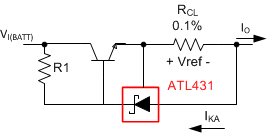SSZTCD7 July 2015 ATL431 , TL431
When designing any system, you’ll often have to design a power supply to meet your requirements. A very popular solution is to employ a switch mode power supply (or SMPS), due to their very high efficiency. However, it is very challenging to design an SMPS while maintaining a low cost, not to mention the risk of creating an unstable loop through a switching regulator. In any power system there is always the risk that the output will experience a short circuit. In such cases, it is necessary to protect the system from damage due to increased current
While you could employ multiple circuits to protect the system from damage, you can also solve this problem with a couple of resistors, a pass transistor and a voltage reference. This total solution is very cost-effective and requires minimal space on the board.
The circuit in Figure 1-1 shows a current limiter with a sense resistor in series with the pass transistor. The ATL431 is an adjustable shunt regulator that feeds back to the pass transistor and inputs, controlling the current-limiting action. When the system has a connected output, the drawn current will begin to create a voltage across the RCL resistor. When the voltage at RCL reaches 2.5V, it will make the ATL431 conduct. This in turn will drop the voltage on the base emitter of the pass transistor, effectively limiting the current that can be drawn.
 Figure 1-1 Power-supply current
limiter
Figure 1-1 Power-supply current
limiterIn order to accurately select the passive components, I suggest using the ATL431’s minimum operating conditions and your desired maximum current. It is best practice to use a current below the power supply’s absolute maximum conditions. For this example, let’s use 50mA as the maximum (Equation Figure 1-1):
 Figure 1-2 (1)
Figure 1-2 (1)You can use these conditions to calculate R1 and get the appropriate β for your pass transistor. We will use 7V as our input voltage, as we need enough overhead to supply the output voltage, and 100 as our β. We are also assuming the output for this system is required to be at 3V (Equation Figure 1-1):
 Figure 1-3 (2)
Figure 1-3 (2)Since the ATL431 is the primary feedback for this current limiter, and this device features an IKMIN of 35µA, you get the benefit of having a very low RCL value. This limits the power dissipated in the resistor and helps relax the β requirements for the pass transistor. As an added bonus, the voltage reference has a maximum accuracy of 0.5%, which means that the maximum IOUT allowed will only fluctuate by 0.246mA.
Conclusion
It is very simple to implement overcurrent protection using a reduced number of components while obtaining high-precision functionality. By employing TI’s very low current programmable voltage reference, the ATL431, we can ensure a reduced overcurrent margin, making our system very high precision. This circuit can be used, not only for short-circuit protection but to limit battery power consumption as well. Log in to post a comment below, to let me know what you think about this circuit or check out our blog on selecting the right power supply for your system!
Additional Resources
- Simulate this design yourself using our WEBENCH tool.
- Download the ATL431 datasheet.
- Read the application note, “Designing with the ‘Advanced’ TL431, ATL431.”
- Start your design in WEBENCH® Power Designer.
- Download the ATL431 Pspice transient models.
- Get the ATL431 evaluation module (EVM).
- See all our voltage reference design how-to blogs.